This week’s Finish Line selection is focused on quilts begun in past Maine Quilt Retreats. I love sharing Maine with my students and it’s a nice change of pace when I can teach but don’t have to hop on an airplane to do it. So thank you to these ladies for sharing, and enjoy these Finish Line quilts. I hope to see you in one of my Maine retreats sometime soon.
Harpswell, Maine: June, 2015
In the photos above and below, Karen Amelia Brown graciously posed with her work-in-progress from a retreat more than three and a half years ago, though it’s been finished for awhile now.
Back in June of 2015 the thought of writing a blog hadn’t even crossed my brain yet, so I only kept final photos for reference from the classes I taught. But at least I have Karen’s exuberant face caught in time—and yes, she’s as nice as she looks.
I had the pleasure in November of that same year to see the completed Delilah the grasshopper at the Houston International Quilt Festival, where I was having my own special exhibit of my Specimens quilts. How fun to see another quilt that I was so familiar with.
When I contacted Karen for this blog post, she told me about another exhibit Delilah’s is currently a part of:
Thank you for giving Delilah some press. She has been on tour with the Sacred Threads traveling exhibit – I’m eager to have her come home. I’m attaching a photo and her story for your use. It will be fun to see her online again.
This quilt was inspired by poet Mary Oliver as Karen explains below:
Mary Oliver’s poem, “The Summer Day”, fills my heart and soul, awakens me with each reading, and demanded to become a quilt. She asks “who made the world? … the swan and the black bear … the grasshopper?” She studies the grasshopper intensely and shares the details of its movements, then admits she does not know “exactly what a prayer is” but tells us she knows “how to pay attention.” She then speaks of falling down into the grass, kneeling down in the grass and “how to be idle and blessed.” This poem describes my perfect summer day. I knew that the grasshopper, who quickly became known as Delilah, was to be the central focus of this quilt. She stands in front of the world surrounded by the bright blue sky and the many greens in the grass and invites the viewer to come closer and recall one of their summer days.
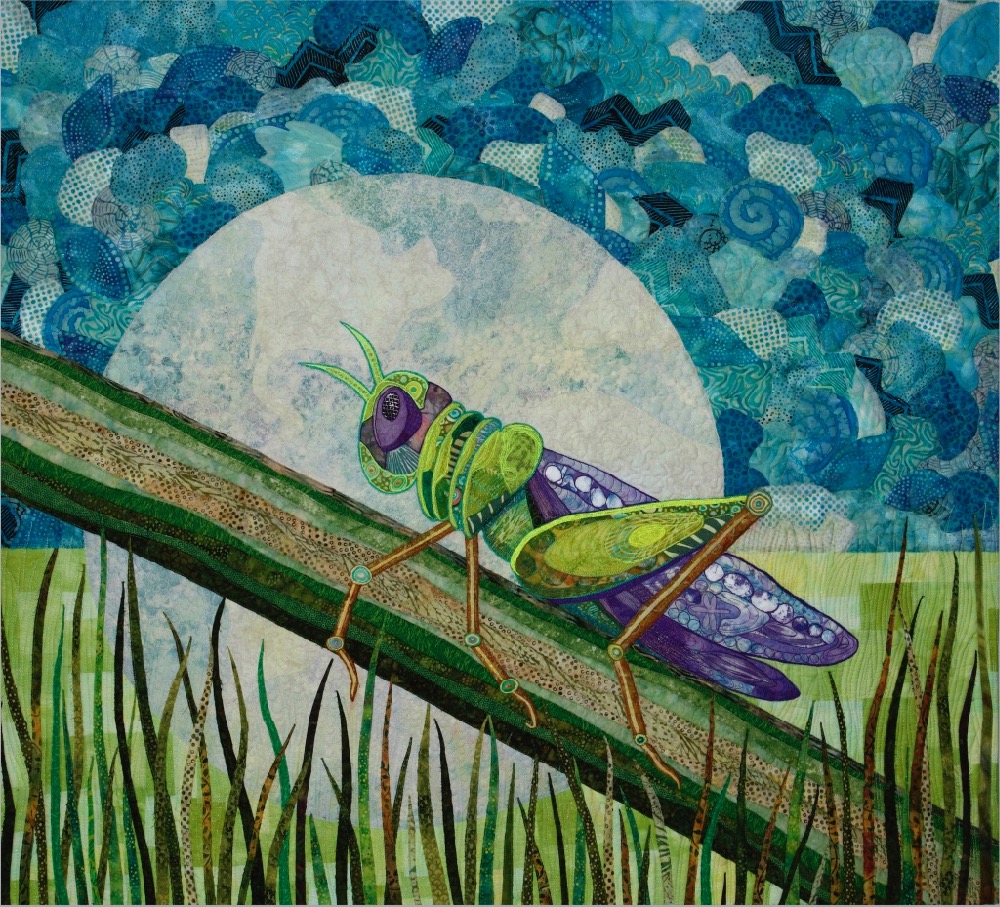
Portland, Maine: Advanced Retreat—October 2016
In 2016 I hosted my first retreat for students who had taken two or more extended (longer than two days) classes with me—I called it my “advanced class.” These were people for whom I figured I could skip my morning demo/lectures. They had heard it all from me before, at least twice. Instead, I could make the comfortable assumption that they understood what certain terminology I use meant, and we could jump right into continuing a project they had already started, or get a new one going. Kinda like group independent study. It worked great.
Sally Evans was in that first advanced class experiment and brought two quilts for show-and-tell and another two to get started on—one of which, a landscape, is pictured below. After this retreat she began and completed yet another collage, a parrot that’s included in the recent Finish Line Aviary—Second Edition.
Step by step you can see how Sally built up her autumn landscape.
Since I needed a little reminder of the what’s and why’s of her landscape for this post, Sally’s reply is below. Click on this or any of the photos in this post to see them larger—you may want to when you read what Sally describes.
I wanted to do something different with the landscape and hide little creatures in it—probably doesn’t show very well, but the tree to the far right has a horse head, tree to the left has an antelope head and an owl, at the bottom there is a bird and some other creatures or at least eyes of them. And the bird on a branch of the tree on the right. I took it to work and had my coworkers see if they could find all the hidden animals. Fun stuff!!
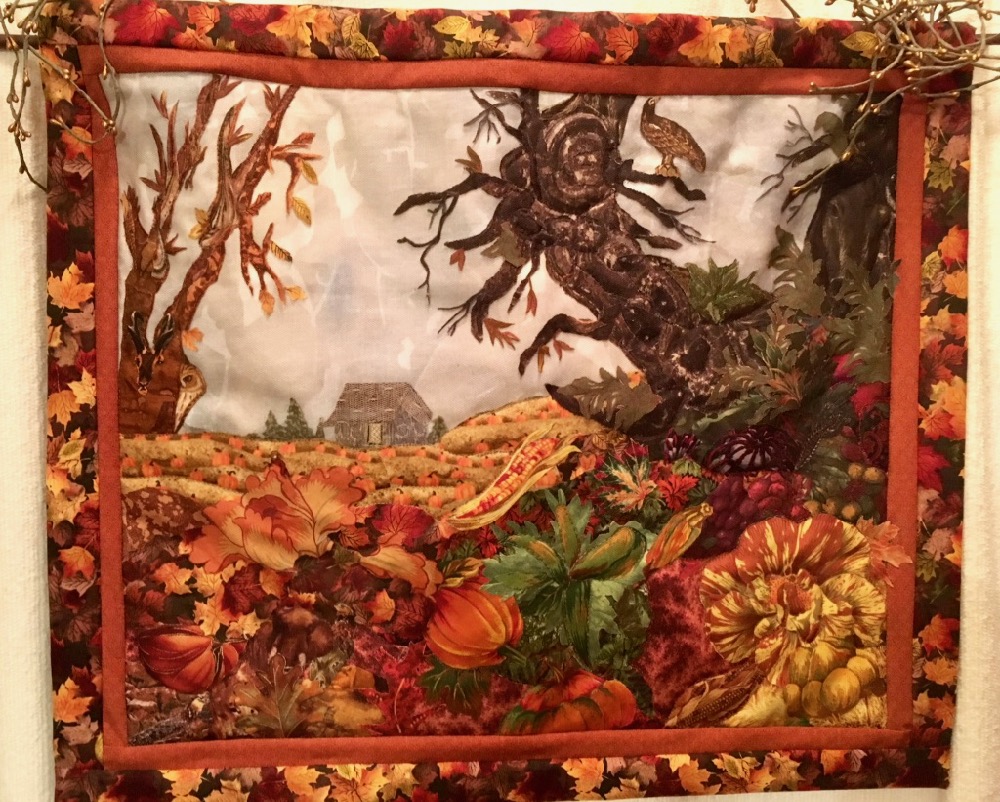
Portland, Maine: May 2017
I met Bea Englert in the Maine retreat linked above. She arrived with a photo she had taken of Michelangelo’s sculpture David. I can never be sure how someone’s brain will work adding color to a black and white image, but I won’t discourage someone from doing it! And Bea already had it in her head to do so, as she told me below:
Seeing Michelangelo’s statue of David in person is one of the highlights of my life. I thought that representing a white, cold, marble statue in my favorite bright colors would be interesting; it was exciting to find fabric patterns that would give the shading and contour of a face. Your habit of taking a photo on your phone as the pieces progress is brilliant; the photos somehow highlight the colors or patterns that don’t fit.
I remember hearing that Michelangelo said he saw his sculptures as already existing in the slabs of marble he worked on. His job was to clear away the excess rock confining those figures. He had a pretty good eye for it too. But I sometimes think of how he saw his art, as I look at my students’ art emerge from the blankness of the foundation fabric. Colors and patterns come together and and an image emerges, like it was trapped in the fabric and just needed to be released.
That might be a little dramatic, but you can see that idea in the progress shots of Bea’s David, above and below.
I saw Bea again in a class in Montana this past June (below), where she brought a finished “David” to show me and began a pelican collage.
As Bea says:
I loved taking the Maine and the Montana workshops! Thanks for so much fun and inspiration. I’m sending you a couple of photos. I am happy enough with the pelican, but see how it needs some improvements. Happy, happy 2019- hugs from Bia
I want to point out the background in the finished quilt. Instead of museum walls, Bea chose a montage of Italian Renaissance architecture to place her image in the time Michelangelo belonged. Nice finishing touch.
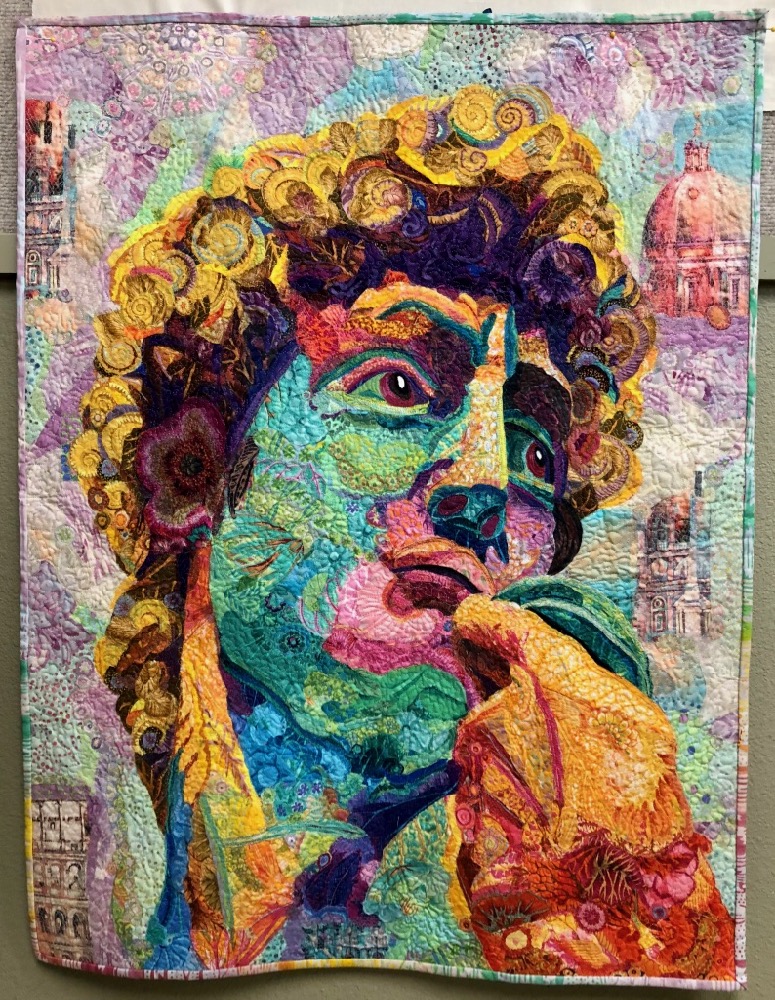
The Quilt Gallery, Kalispell, MT: June 2018
I know, I know, I said this was all about Maine retreats. But when I contacted Bea, she sent along a photo of her finished pelican, begun in Montana. I’m sure you’re curious as to how it turned out after seeing it in an above photo her mentioning it the above quote. So here you go, beginning to end.
The image above is from the end of class. You can see that Bea’s original photo has the pelican sitting on a boardwalk—and that’s the last I knew of her plans.
Below is the finished quilt and what a nice change in direction she made. The way she treated the water looks great—you can almost see a gentle movement of the current—and the bird’s reflection is very believable. And that sky—like a fantastic sunset that’s casting it’s colors onto an otherwise not-so-colorful bird. A theme that obviously attractive to Bea.
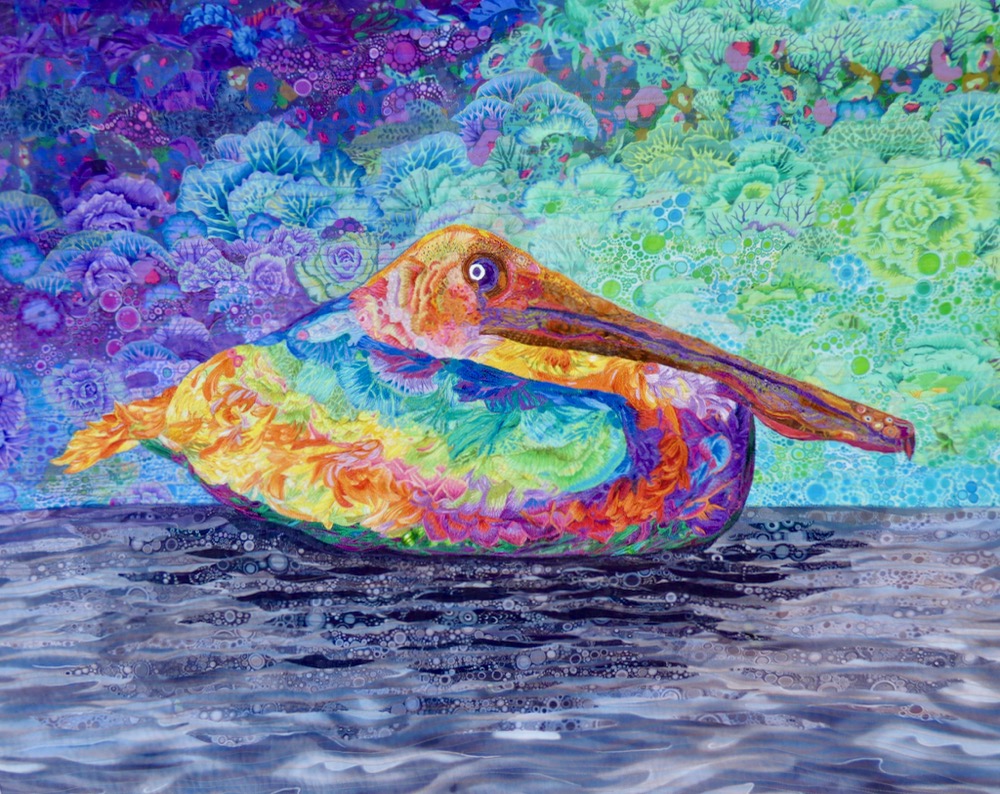
Portland, Maine: October 2017
Back to Maine now. The next three finished quilts were all begun in a retreat a little more than a year ago. Interesting enough, when I went back to review the original class post (linked above), I noticed that I happened to begin that post highlighting the three following ladies.
Here’s Martha Ginn with “Elizabeth the Almost Perfect Cat” begun that October and can be seen finished at the end of the Finish Line #7 post.
I include this photo of Martha in class with Elizabeth since late last year I received a follow-up note from Martha telling me that she had finished a second cat quilt which had been her Option B for retreat week—a quilt of all three of her cats—Rahrah, Tarbaby, and Elizabeth, “on a table looking for lizards or other creepy crawlers.”
From Martha:
The pdf is my drawing/pattern [Nice pattern, Martha]. The next is showing the photo inspiration and the beginning shapes. Tarbaby’s back was a challenge because it is so deep-dark black (see the pics of him posing with long legs and of him hanging off the sewing machine). I used satin, flocked organza, velvet, lace, and prints to give texture and definition to him.
I thought I had a few detail shots of the variety of fabrics necessary to depict Tarbaby’s sleek black coat but apparently have deleted lots of in-progress ones. I know this is TMI and don’t expect you to use in the blog, but I’m including some photos of him for your enjoyment and admiration of this very special guy!
I decided to include the kitty photos anyway, why not? It’s a good example of the treatment of a black animal. Solid colored animals are a challenge in the sameness of the fur, and black is toughest since it’s often hard to get a good photo that shows the form of the animal. Martha did a very nice job catching the idea of sunlight on dark fur.
The characters in this second quilt are Rahrah, Tarbaby, and Elizabeth intently studying something in the yard. I used a muted floral with organza overlaid for the bush outside. I used organza over yellow for the sunlight on the table.
Martha often makes insightful and appreciated comments on my blog posts. She was also a tester for my online course: Fabric Collage Online Master Class Manual. So I’ll let her make this unsolicited plug for me:
I do plan to have more fabric collages in the future! Meanwhile I enjoy all your finish line posts and am glad I have the course downloaded for refreshing memory. —Fondly, Martha
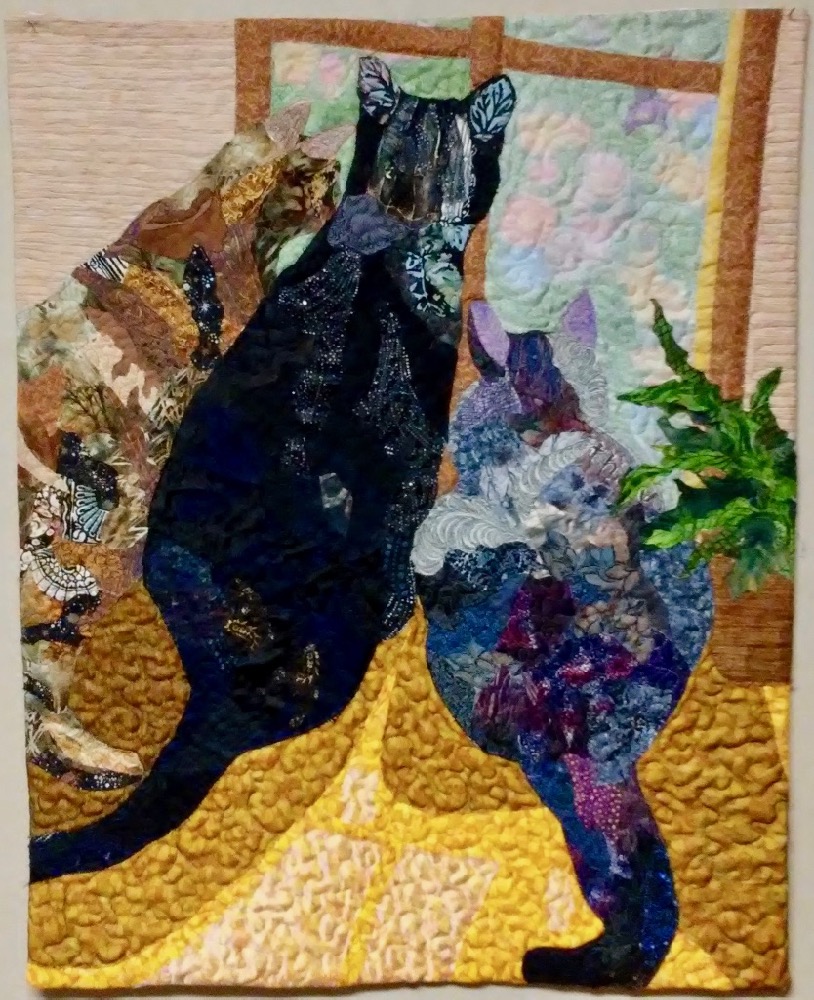
Portland, Maine: October 2017
Jan Simpson was also in that same retreat with Martha and her cat, but Jan dove into some sea life instead. As I noted in the original post, Jan moved uncommonly quickly on her collage. She went from start to finish on her quilt in the five days, minus the final binding. Not too shabby, as they say here in Maine.
When I look at Jan’s turtle, I see a nice use of large patterned batiks that blended nicely together in colors and values, but still had touches of contrast—especially in the warm yellows and oranges to give the shell highlights and a sun-kissed look.
The background was a bit stark until Jan added “currents” of a bubbly batik and strips of netting and tulle, giving variation and visual interest to the warm hued ocean.
I don’t often get action shots of quilting happening in any of my classes, but Jan proved it’s possible.
In this close-up you can see the variety of patterned fabrics Jan had to work with. She also cut around the designs in the fabrics nicely, creating “organic” edges that blended well. And she didn’t worry it, working intuitively and moving forward.
She told me she’s now working on a purple dragon and that I’m in her head telling her to, “Let your fabric paint the picture.” She’s got the idea, and really, this turtle looks quite painterly, with a looseness of “strokes”—can’t wait to see that purple dragon. Try to find that place you were at in class, Jan, and you’ll do fine.
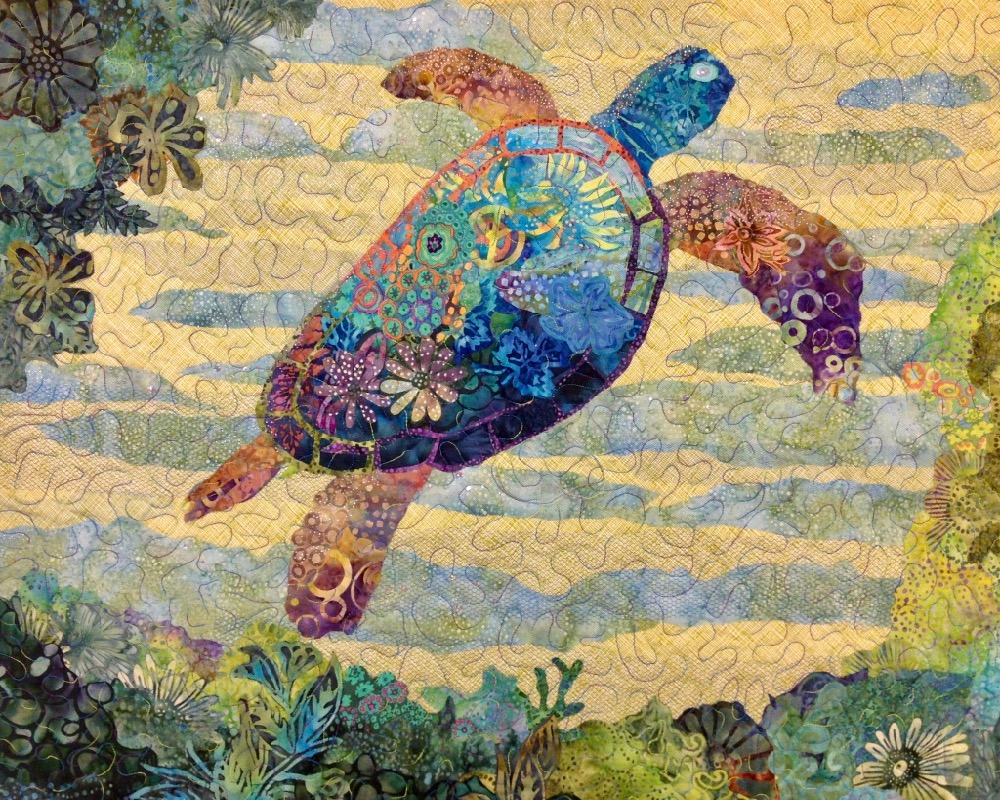
Portland, Maine: October 2017
And finishing the selections of this Finish Line post is Mary Cannizzaro and her husband Joe. While Mary was in class, Joe explored Portland, stopping in at the end of each day to inspect her progress on his portrait. Mary is in the quilting business—Cannizzaro Creations—with her daughter Jen, quilting, teaching, and writing books. Their book, Beyond the Tee: Taking T-Shirt Quilts to the Next Level, has just been picked up by C&T Publishing, my own publisher. Congrats Mary and Jen!
Mary sent me a great write-up for this post, so I’ll let her explain this collage portrait herself:
I took this picture of Joe and always loved it. Little did I know just how much I would really know this photo by the time I finished the quilt. When I signed up for the class, I wasn’t going to use this photo because I wasn’t sure I’d get the eyes right. Then I realized that I would be in your class for 5 days and if I couldn’t get those eyes right with you guiding me, then I never would. I think you were a little apprehensive about my using it but I think once we started, you knew that I was jumping in with both feet.
I love the color choices I’ve made. When we were younger, my hair was very red and Joe used to tease me that my hair was orange because he knew I hated it when he said that – and so, turnabout is fair play and my first decision was to give him orange hair!
Mary is another student who has used her fabrics to their full advantage—using the curves of petals and leaves to create the curves and contours of Joe’s cheeks, forehead, and even hair.
Above is Mary, “Portland Joe,” and Joe at the end of the retreat. Mary had already turned to a very graphic print for Joe’s shirt and she was talking about continuing with that sort of contrast to the realism of his face as she worked on the background.
A couple months after the retreat ended, Mary sent:
Since I was in Maine in October, the only moment I’ve had to think about collage was the first day looking at your online class (at 5 a.m. before anyone else was awake). I am happy to be a part of the process and plan on starting my spiral next week.
We have had such a busy fall that Portland Joe has been looking at me from the design wall, but alas, has had to be ignored – until yesterday and today. I’ve been working on the nose, the hairline and right cheek. I’m also thinking that possibly the ceiling should not have black between the striped fabric, but want an opinion before I unglue! I’m attaching my original photo, the sketch, where I was after class, as well as today’s photo (below).
I think I told her that I liked the perspective of the ceiling, but where it met the back wall was a little wonky. And in the final version (below), you can see how good it all looks, especially with the shadows she added—probably with some black tulle or netting.
Mary recently added:
The part I found most difficult was the hand [compare hand in photos above and below]. Many, many hours were devoted to the hand. I used a netting—I think it’s what used to be used on women’s hats to give it the texture I was looking for. I am pleased with the results.
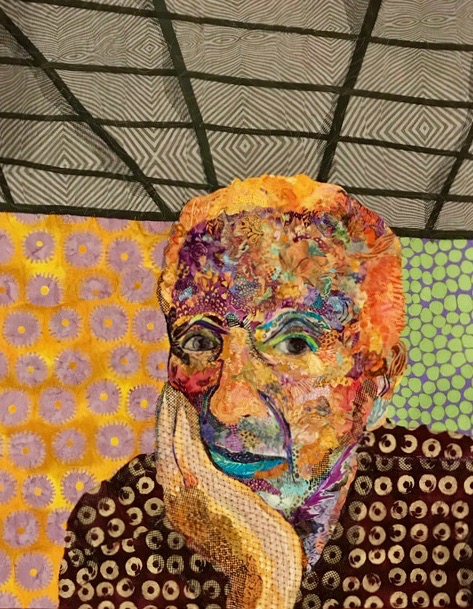
The most important lesson I took away from the class was how to really – really look at the photo. You helped me see that while Joe was looking at me, his face was at an angle, his hand was pushing up the cheek, the nose was also at an angle, the hand had so many nooks and crannies and on and on. I enjoyed every minute of the class.
As it turned out, the eyes are my favorite part of the quilt. I really feel like he’s looking at me – they are his eyes! The detail photo is of the eyes.
In the detail shot above, you can see Mary’s nice use of black netting to achieve some final shading and detail on Joe’s face.
And as a final touch, Mary had fabric printed for the back of the quilt by Bags of Love, similar to Spoonflower—Joe’s idea. She manipulated the original photo in black and white – doing mirror images and, as she says, “something else” to have gotten the image “just right.”
Not too shabby either, Mary.
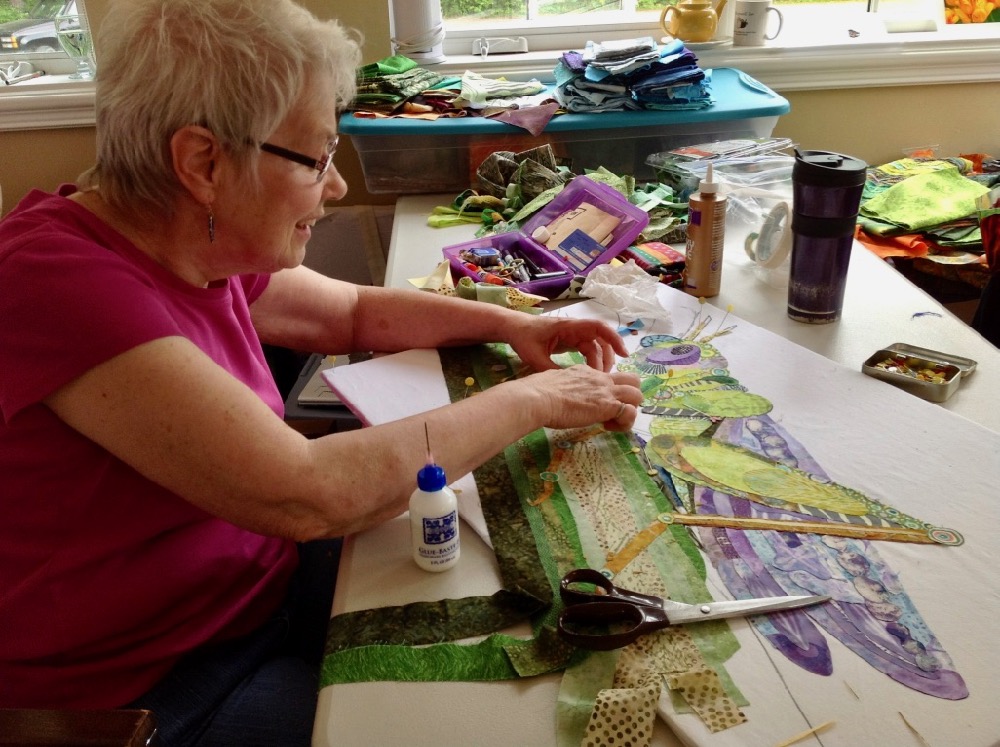
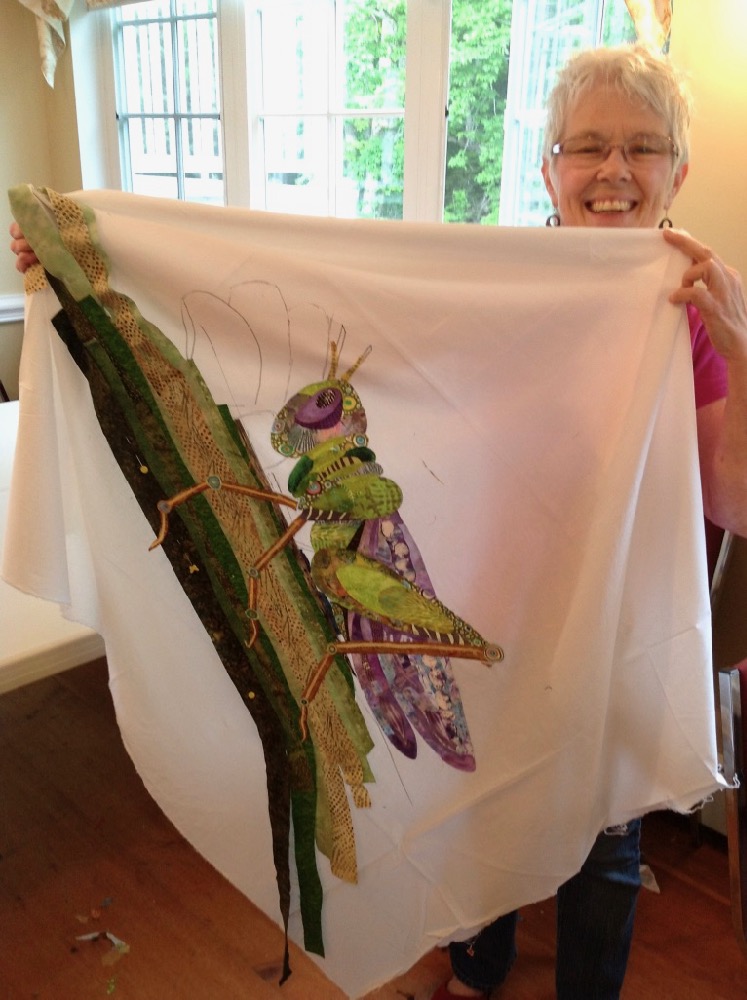
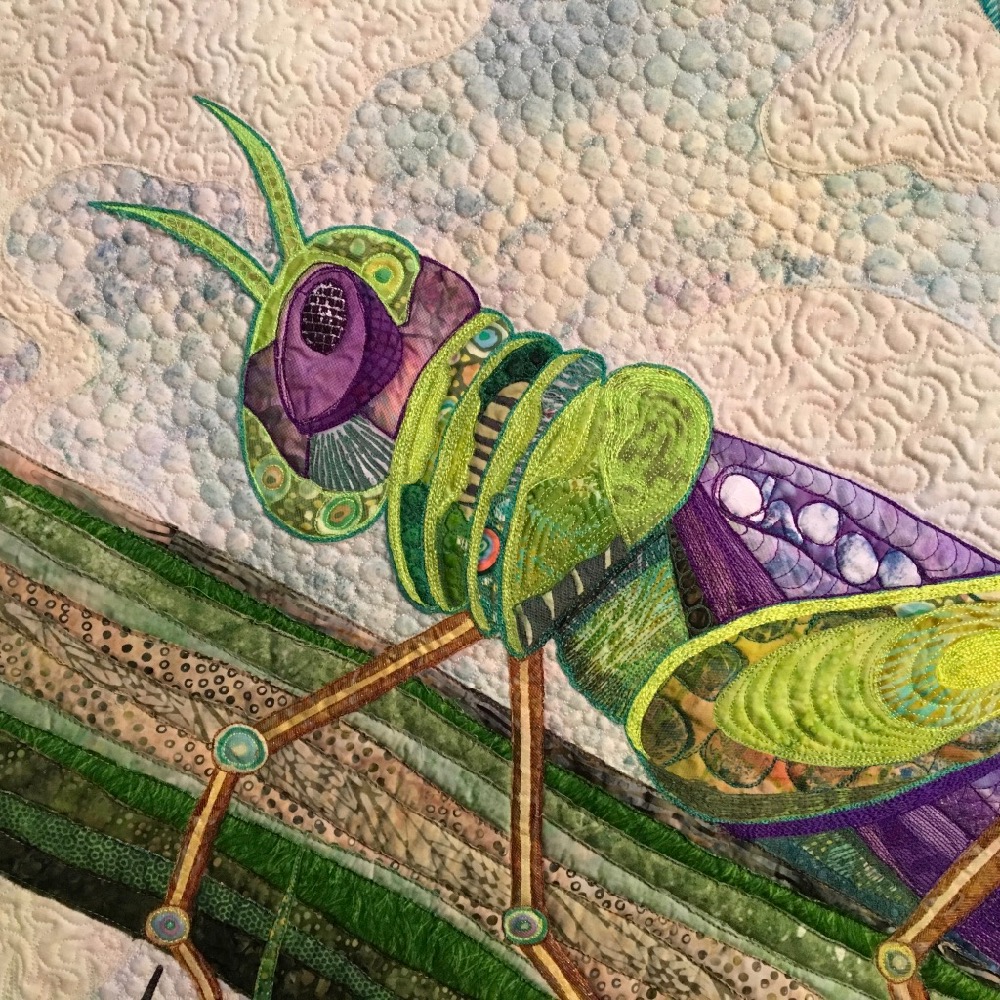


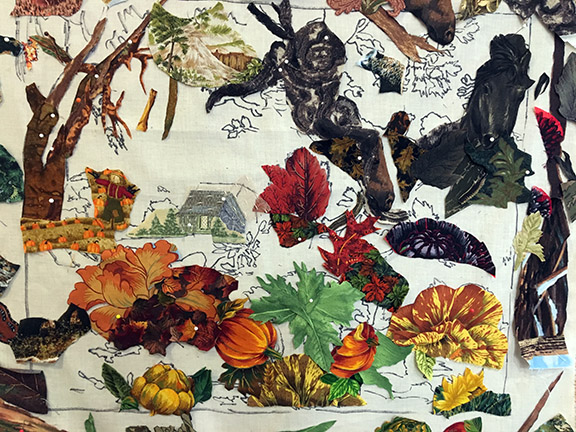




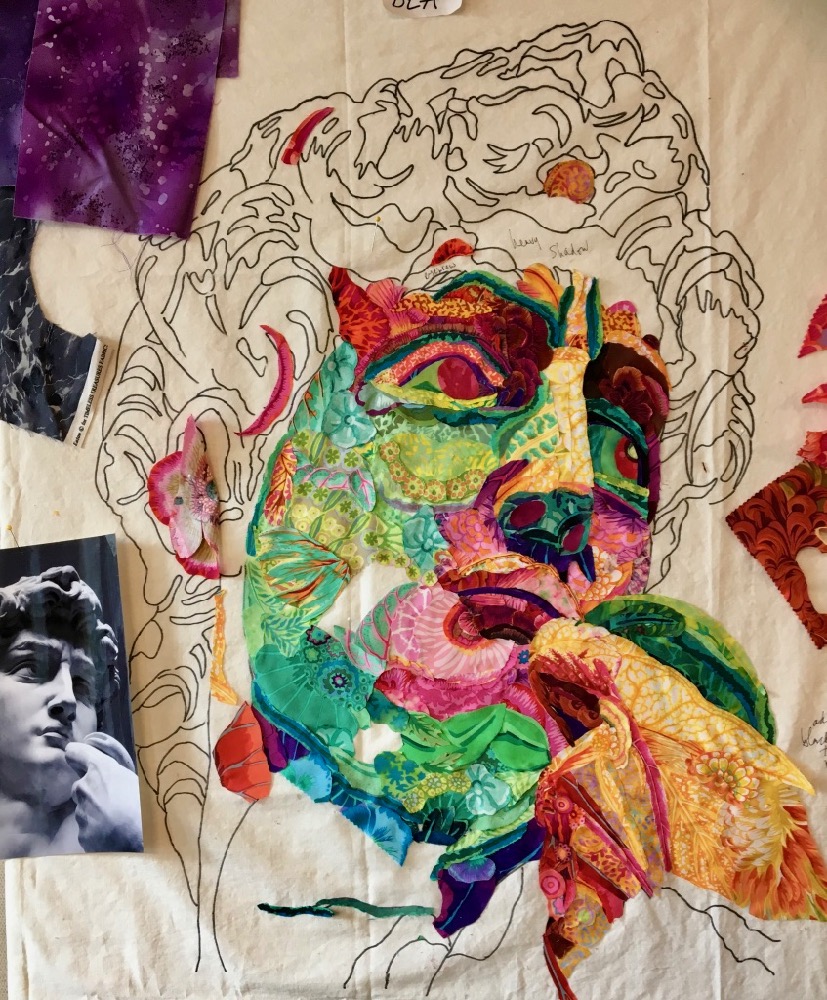
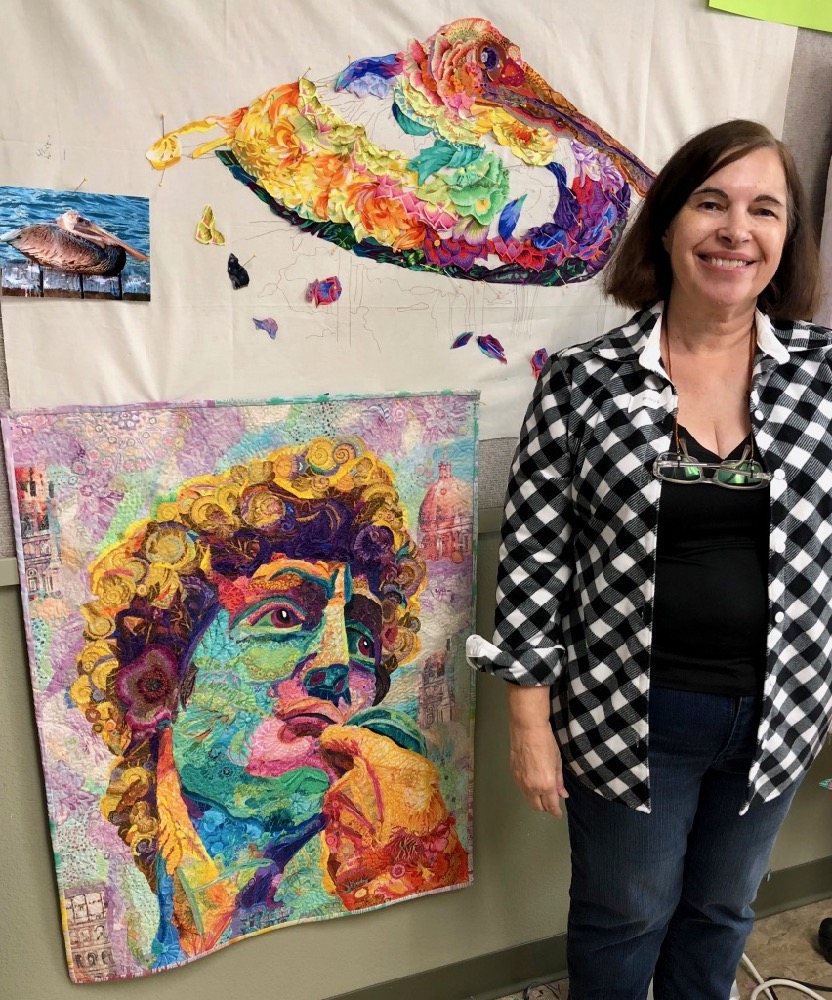
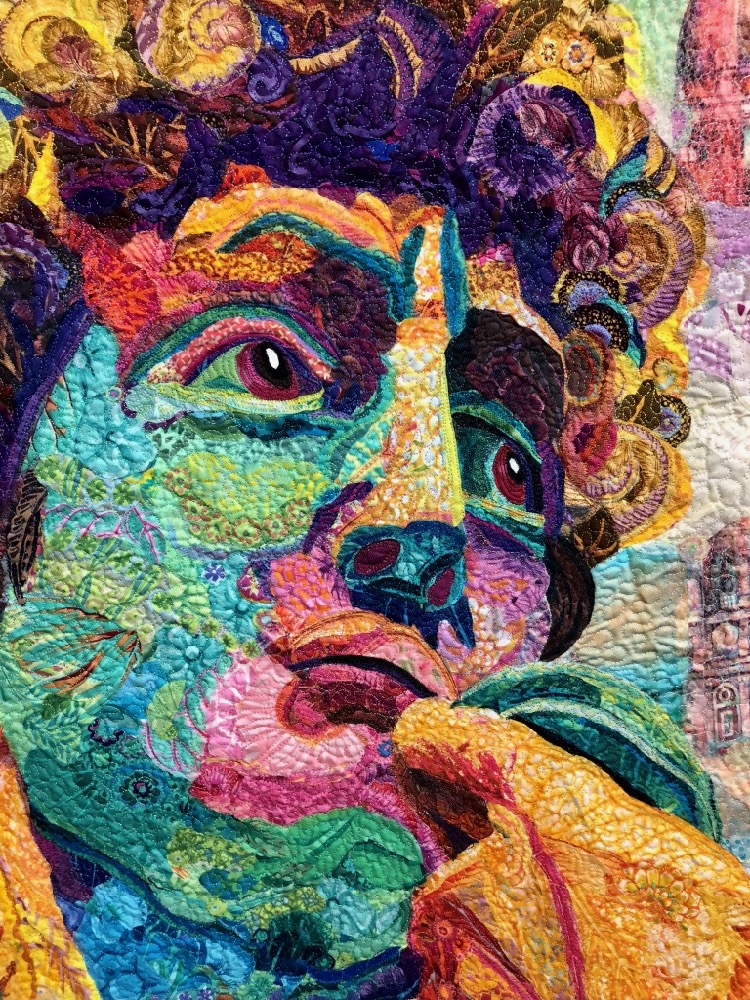




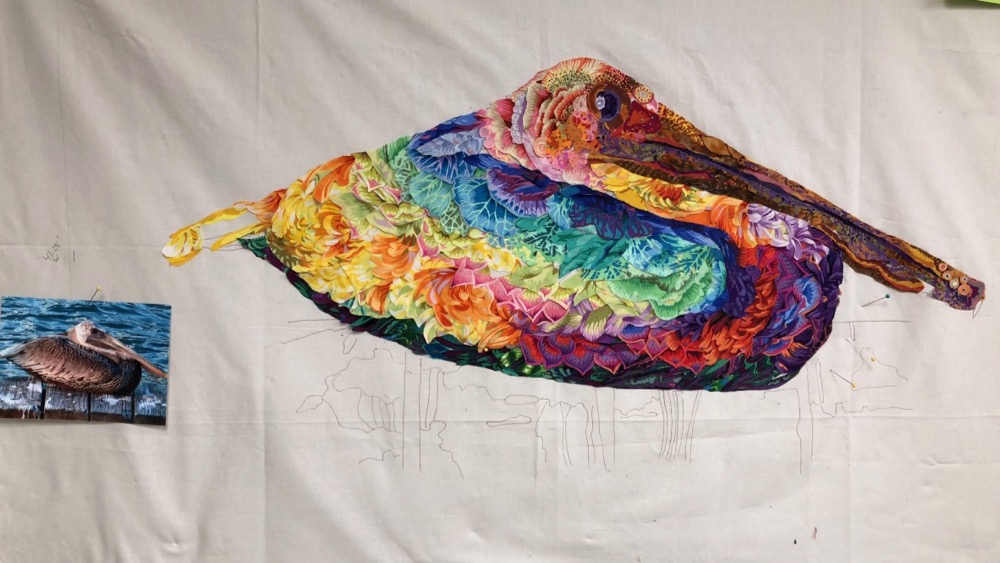
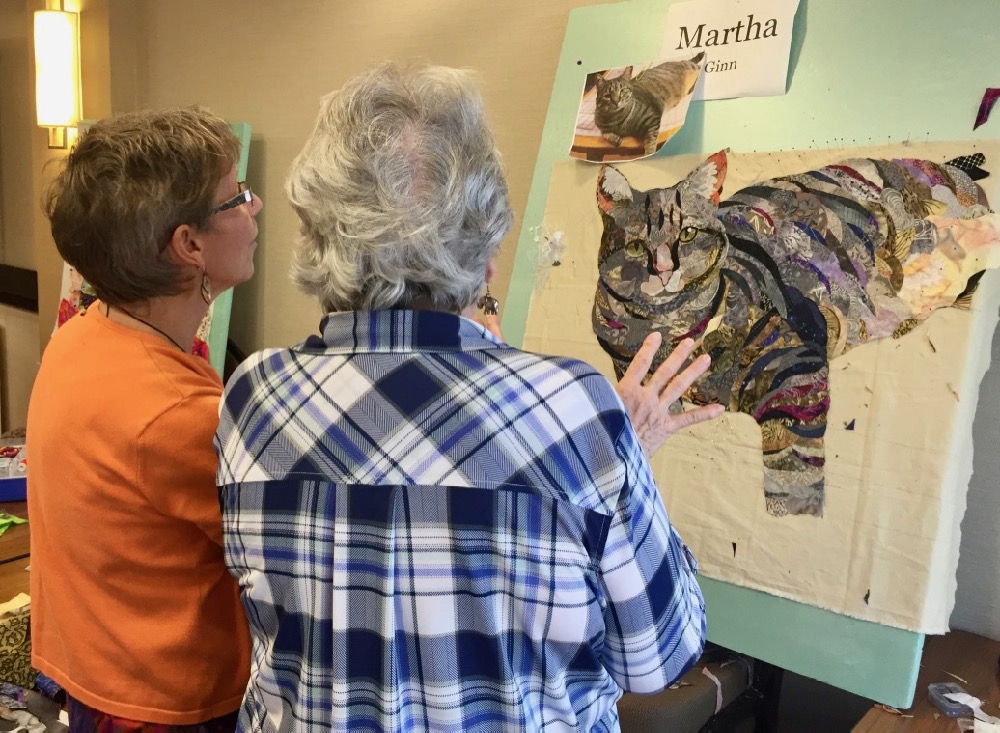









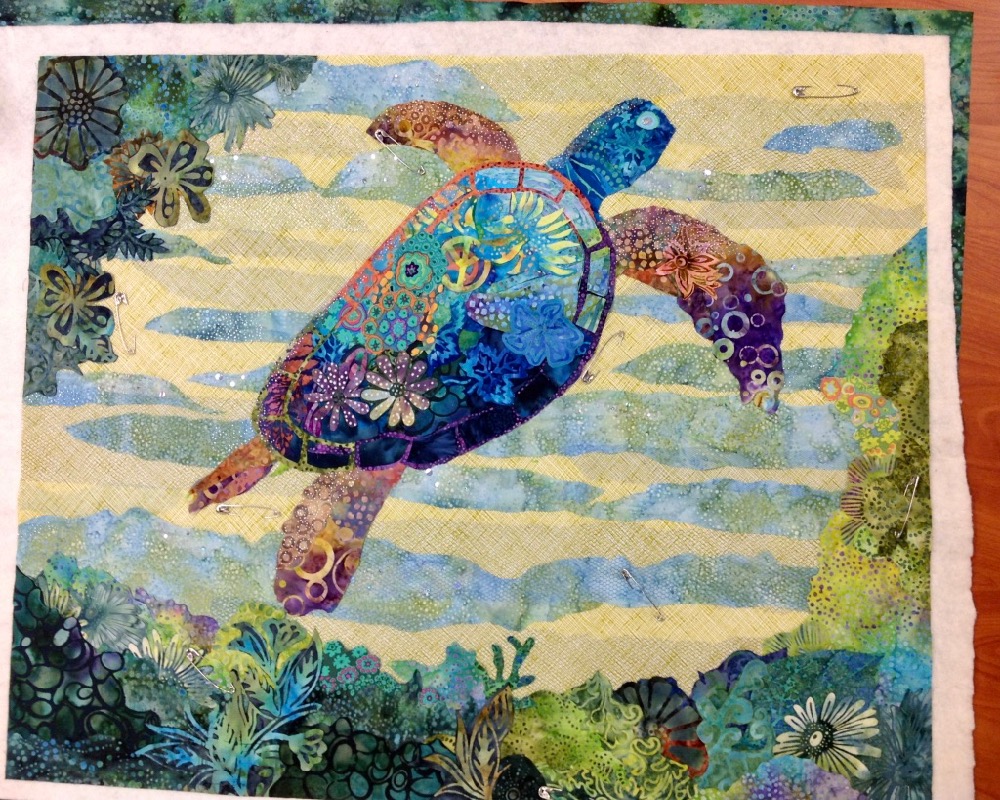









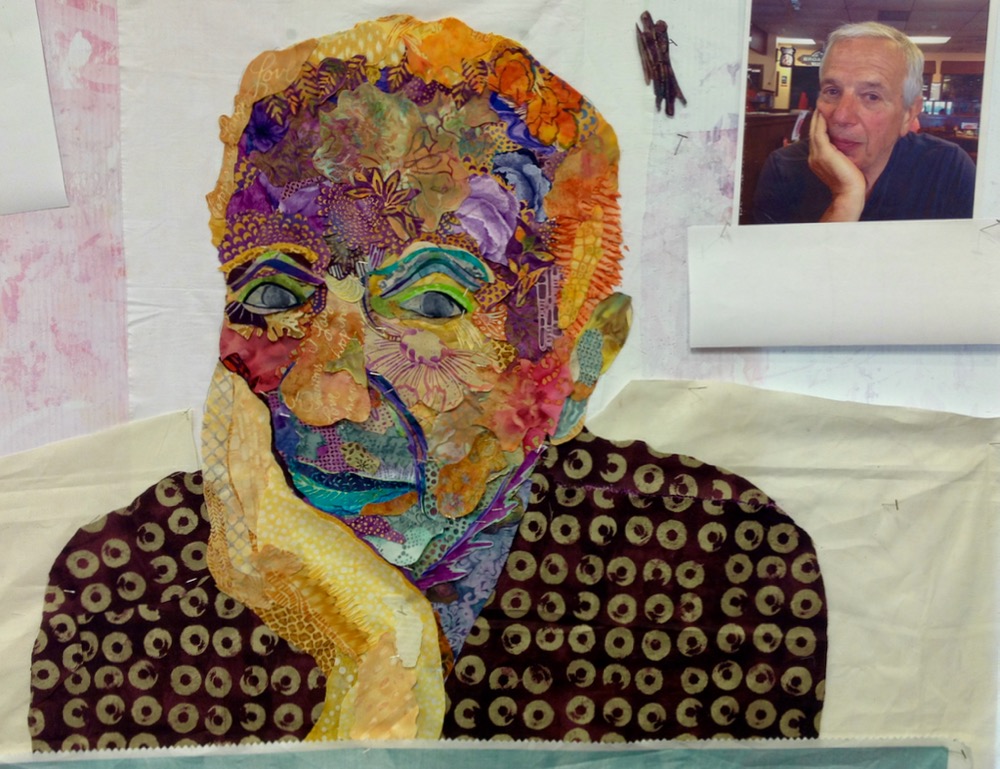
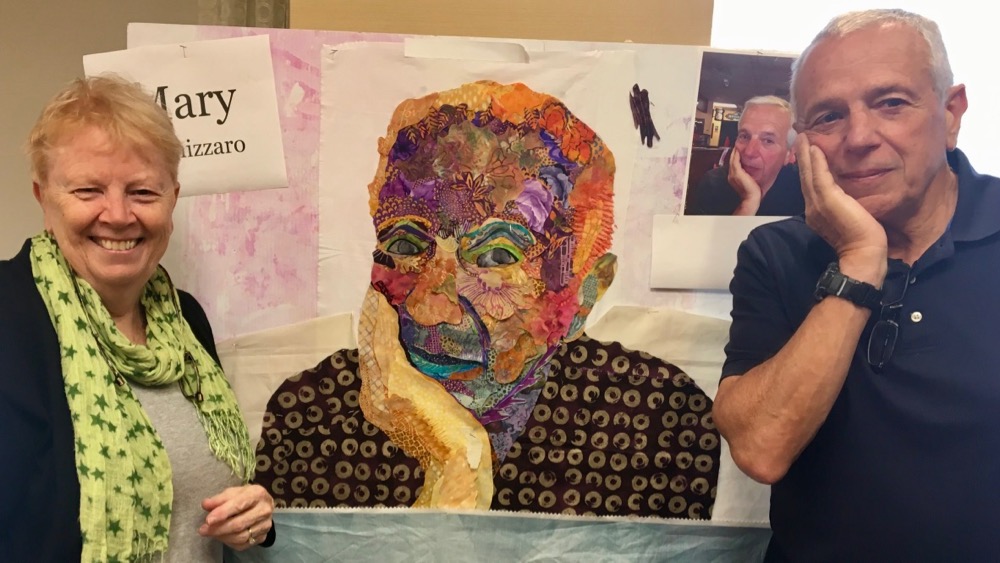
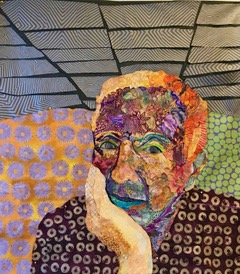
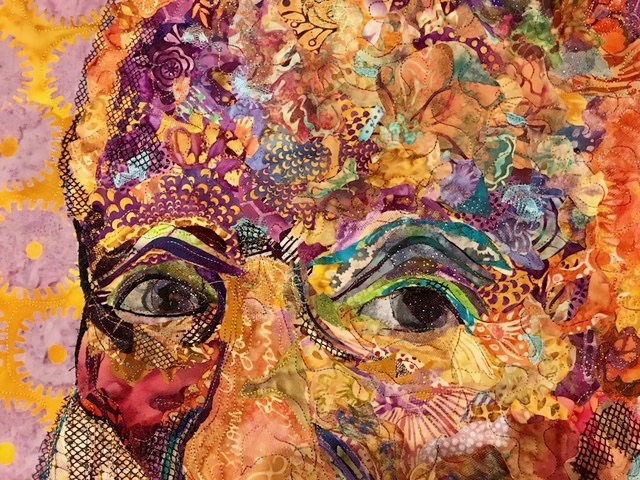
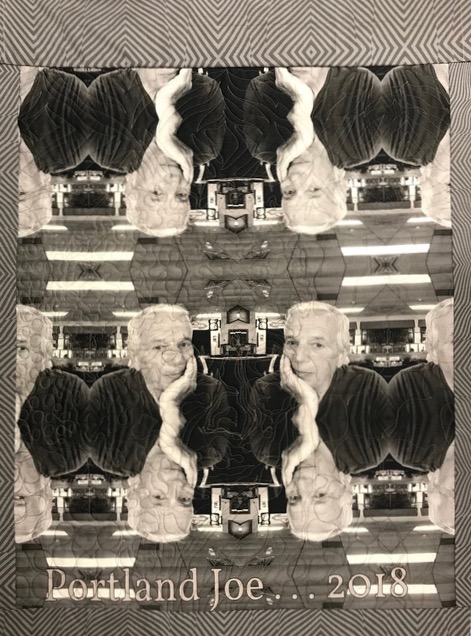
Delilah shines again – WOW. Thanks Susan for featuring my quilt in this post. Karen
Karen, I tried to see if you stitched each reed individually or if there’s netting over them. Finished art work is awesome. Would you explain how you finished it please and thanks!
MG
MJ. Thanks for your comment. I did use tulle in the sky. I used the shapes of the pieces in the sky for the free motion stitching. I used tulle in some areas of the grass, then positioned the reeds and stitched each reed in place. So, no tulle on the reeds. I continued the quilting of the grass between the reeds. It was all done on my domestic Janome Horizon. I hope this answers your questions. Karen
Loved the breakdown on Portland Joe. Very well done. Love the background as well!
For Bea Englert: I got to see the David 2 years ago & love your version but the background is PERFECT!
This blog post came at a perfect time to cheer me–the day I was going back to hospital for more surgery on my infected finger caused by Tarbaby’s bite when he thought I had his treat bag. He is a dear and is sorry for the trouble!
Since I was in the Portland October 2017 class with Mary and Jan, it was especially rewarding to see their finished pieces (Portland Joe and Sea Turtle) here. My Window Watchers piece was a challenging joy to make after the class–on my own–and offered several learning opportunities, such as depicting the black fur and deciding how realistic to make the background. I am looking forward to more fabric collage quilts.
Hi Mary & Jen,
Amazingly creative stories of each special quilt.
I’m so impressed with the depth and breadth of your work and your students.
Keep up the good work. Love reading your blog.
Hugs,
Blanche Goodwin
Love seeing the progress of these and each one is beautiful. A testament to a great teacher. I was a student of October 2018 and am back in Maine for the week with my quilt working on glueing edges as I get closer to the finishing work. I am sure Susan will remember my Abby peaking around the tree. Thanks for sharing these, Susan. I have to say that I love Delilah.